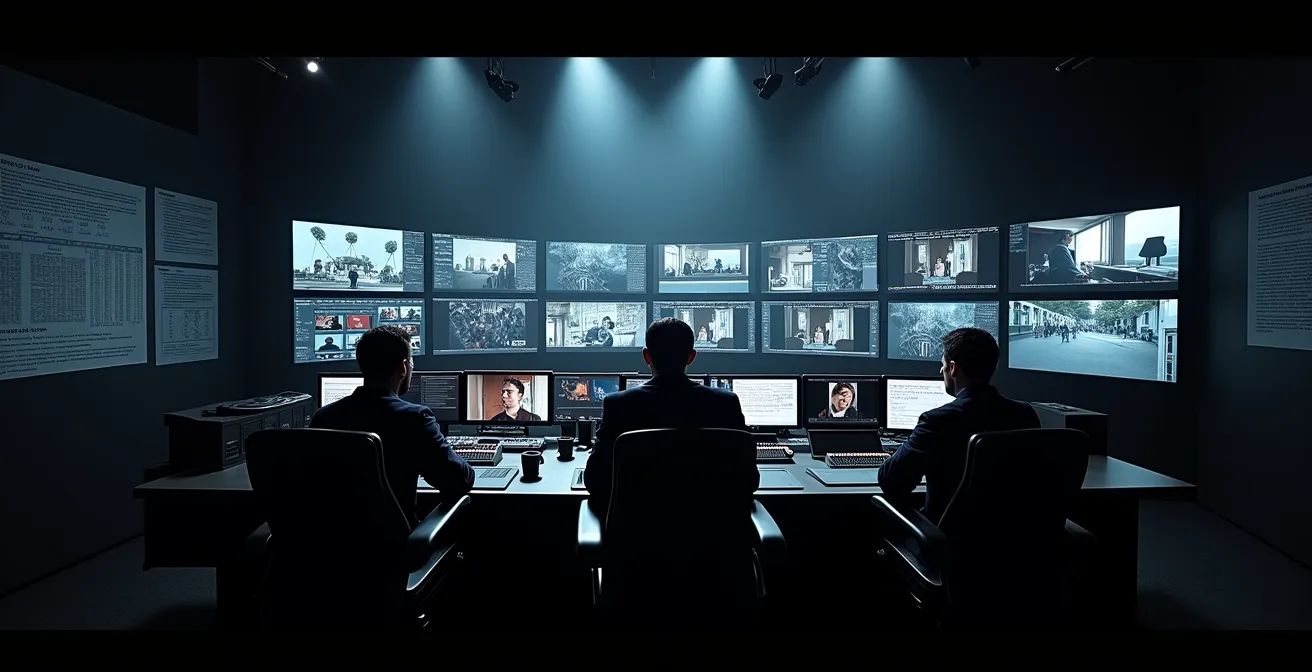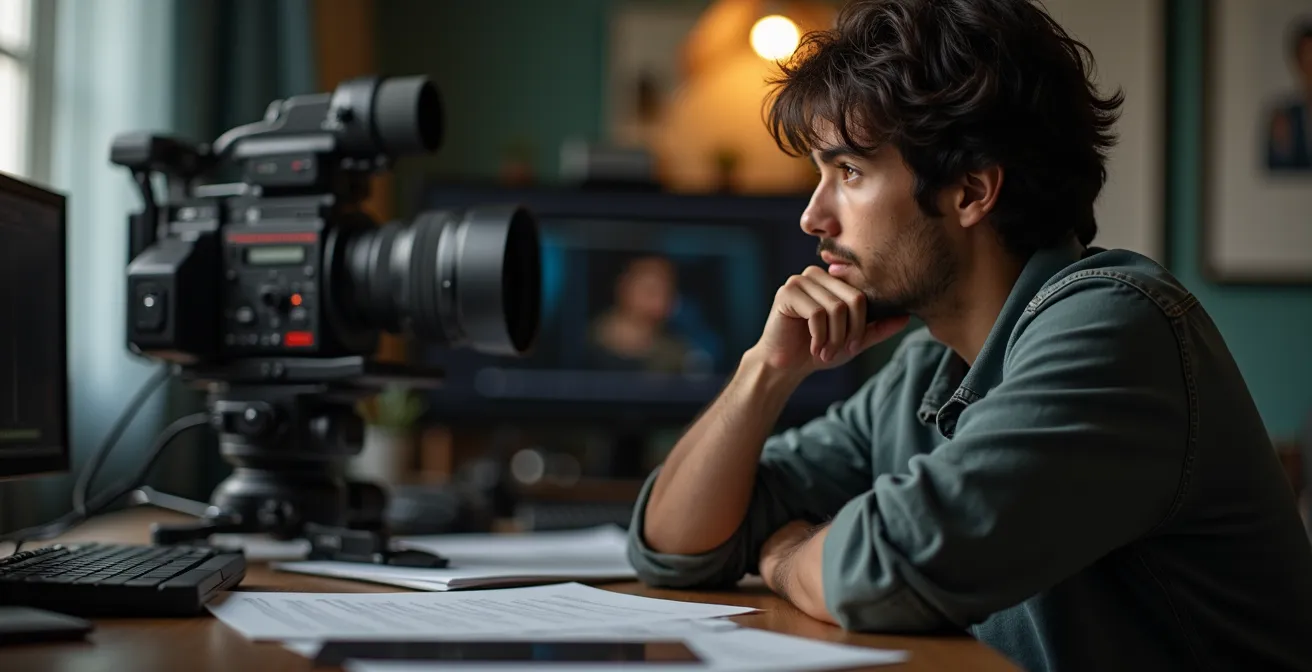
Blockbuster filmmaking isn’t about art; it’s a calculated industrial process where risk management and franchise formulas dictate every creative choice.
- “Hollywood Accounting” is a strategic system designed to show paper losses on even the most successful, billion-dollar films.
- The collapse of the “theatrical window” is a deliberate studio power play to dominate the more profitable world of streaming.
Recommendation: To truly understand Hollywood, you must learn to ignore the red carpet and follow the money trail.
The flashing bulbs of a Hollywood premiere, the larger-than-life faces on a skyscraper-sized billboard, the roar of a T-Rex brought back to life—this is the magic of the movies. For most, the process of creating these cultural events is a black box, a mystical alchemy of visionary directors, charismatic actors, and digital wizards. The common narrative celebrates the creative spark, the artistic struggle, and the eventual triumph of storytelling. We are told it’s an art form, driven by passion and singular genius.
But what if that’s only half the story? What if the real script isn’t the one the actors are reading, but the financial model a studio executive is scrutinizing? As an insider, I can tell you that a major studio production has more in common with an automotive assembly line than a painter’s studio. It’s a machine. A finely tuned, high-stakes, risk-averse machine designed to do one thing: generate predictable returns from intellectual property. The “magic” is often a byproduct of a ruthless business calculation.
This isn’t about destroying the romance of cinema, but about revealing the true engine that powers it. We will move beyond the simple step-by-step of “development to distribution” and dissect the strategic thinking that governs the system. We’ll explore the financial illusions, the franchise formulas, and the power plays that define the modern Hollywood machine, from blockbuster films to the seemingly independent world of high-end documentaries, which are increasingly playing by the same rules.
To fully grasp how this intricate system operates, from its financial underpinnings to its technological future, we will break down its key components. The following sections will guide you through the hidden logic of the Hollywood machine.
Summary: Deconstructing the Hollywood Production Machine
- The Investigator vs. The Poet: A Guide to the Different Styles of Documentary Storytelling
- The Ethics of Truth: Navigating the Moral Minefield of documentary Storytelling
- The Budget Illusion: How Big Studios Use “Hollywood Accounting” to Obscure Profits
- The Franchise Formula: Deconstructing the Art and Science of Building a Cinematic Universe
- The ‘Artistic’ Documentary: When Is It Okay to Re-Enact or Stage Real Events?
- The 90-Day War: The Battle for the Theatrical Window and the Future of Movie Theaters
- Cutting the Cord: The Business Revolution Fueled by the Rise of Streaming Platforms
- The New Hollywood: How Technology and Streaming Are Forging the Future of Cinema
The Investigator vs. The Poet: A Guide to the Different Styles of Documentary Storytelling
In the studio world, content is categorized by its business model. For years, documentaries were seen as a niche, prestigious but rarely profitable. The rise of streaming changed the equation. The traditional “Investigator” style—think classic journalism, uncovering facts—and the “Poet” style—artistic, impressionistic filmmaking—are no longer just creative choices. They are strategic assets in a war for subscriber attention. A platform like Netflix, which needs a vast library to satisfy a broad audience, sees value in both.
As one analyst aptly noted, the strategic difference is clear in how platforms position themselves. As they see it, “Netflix is a utility, a place you come to for a wide library of content. HBO is a place you come for guaranteed quality programming every single time.” This “utility” model means even poetic documentaries like My Octopus Teacher must be commercially viable. They succeed by blending artistic storytelling with a compelling, investigative-style narrative structure that appeals to algorithms and keeps viewers engaged. Today, even the most artful documentary must have a business plan, reflecting the fact that Netflix originals account for 9.1% of total US TV demand, making its internal logic the dominant force in the market.
The line between art and commerce has blurred. A successful documentary is now one that satisfies both the critic (the Poet’s goal) and the algorithm (the Investigator’s structure). This is a microcosm of the entire Hollywood machine: creative expression is now packaged for mass distribution. The style of storytelling is less an artistic impulse and more a calculated decision based on platform strategy and audience retention data.
The Ethics of Truth: Navigating the Moral Minefield of documentary Storytelling
Once you understand that documentaries are a commercial product, the ethical questions become far more complex. The “moral minefield” isn’t just about a filmmaker’s conscience; it’s about the immense market pressure to deliver a thrilling, “binge-worthy” narrative. Nowhere is this more apparent than in the true-crime genre. The reason platforms are saturated with these series is simple: they are incredibly popular and profitable. In fact, data shows that true crime documentaries represent 2.3% of total US TV demand, a significant and highly valuable market segment.
This demand creates a powerful incentive to shape reality into a more dramatic, commercially viable story. A filmmaker in an editing suite isn’t just weighing journalistic integrity; they’re wrestling with the knowledge that a more sensational cut could lead to a ratings hit, a second season, and a career boost. The pressure to selectively edit interviews, create heroes and villains, or omit complicating facts is immense when your project’s success is measured in viewership metrics.

As the image suggests, the core ethical struggle happens in the quiet of the edit bay. Every cut, every music cue, and every transition is a decision that can tilt the narrative away from objective truth toward subjective entertainment. This is the central conflict in modern documentary filmmaking: when the pursuit of truth clashes with the demands of the market, which one wins? In the studio system, the answer is often predetermined by the balance sheet.
The Budget Illusion: How Big Studios Use “Hollywood Accounting” to Obscure Profits
If market demand creates ethical pressure, the financial structure of Hollywood creates a world of pure illusion. This brings us to one of the industry’s most notorious and protected secrets: Hollywood Accounting. It’s a collection of byzantine and opaque accounting methods used by major studios to inflate a film’s costs and minimize its reported profits. The goal? To avoid paying royalties and profit-sharing percentages to writers, actors, and other creatives who have “net points” in their contracts.
The most famous example is the 1994 blockbuster Forrest Gump. Despite grossing over $677 million worldwide on a $55 million budget, Paramount Pictures claimed the film never actually turned a profit and remained in the red. As a result, the author of the original book, Winston Groom, received no payment from his profit participation deal. This is achieved through a series of staggering internal fees. For instance, studios typically charge themselves a 30% distribution fee on all revenue, a massive “cost” that goes from one of the studio’s pockets to another. Add in exorbitant marketing, overhead, and interest fees, and a blockbuster hit can magically become a financial loss on paper.
This isn’t an accident; it’s the system working as designed. Screenwriter Ed Solomon, of Men in Black fame, once stated with biting irony: “The studios ARE losing money, just as they say. My recent Men in Black profit statement proves that the film, though having generated over $595 million in revenue, has actually cost Sony over $598 million.” It’s a perfect illustration of a system where profit is a number to be manipulated, not reported.
Auditor’s Checklist: 5 Signs of Hollywood Accounting
- Gross vs. Net Points: Scrutinize contracts. “Net points” are almost always worthless; the real money is in “gross points” (a percentage of total revenue before deductions).
- Distribution Fees: Look for large, flat-rate “distribution fees” (20-40%) charged by the studio to itself. This is a primary tool for inflating costs.
- Overhead & Marketing Costs: Investigate studio “overhead” charges and massive, often unaudited, marketing expenses that are billed back to the film’s production budget.
- Interest Charges: Check for high interest rates charged by the studio on the very money it fronted to produce the film, creating a self-perpetuating debt.
- Cross-Collateralization: Determine if profits from a successful film are being used to offset losses from other, unrelated productions, a common tactic in franchise deals.
The Franchise Formula: Deconstructing the Art and Science of Building a Cinematic Universe
If Hollywood Accounting is the system’s defense mechanism, the “Franchise Formula” is its engine of growth. In an industry terrified of risk, original ideas are a liability. A known property—a comic book, a best-selling novel, a beloved toy—is an asset. Building a cinematic universe is the ultimate risk-mitigation strategy, turning moviemaking from a series of high-stakes gambles into a predictable, interconnected assembly line of content.
The scale of this strategy is staggering. The total industry investment in content production reached $115 billion in 2022, and a massive portion of that is dedicated not to creating new worlds, but to expanding existing ones. The formula is deceptively simple: introduce a core set of characters, establish a world with expandable lore, and then use sequels, prequels, and spin-offs to endlessly mine that intellectual property. Each film acts as a two-hour commercial for the next, creating a self-perpetuating cycle of revenue.
This industrial approach is now being perfected outside the traditional studio gates. Visionary creators like MrBeast and Dhar Mann have built their own “studios” that operate with the efficiency of a tech company. Dhar Mann Studios, for example, operates across over 100,000 square feet with 200 employees, producing content with film-level production values at a fraction of the cost. They have mastered the art of creating formulaic, emotionally resonant content that is perfectly optimized for a specific platform and audience. They are, in essence, the new franchise builders, proving that the formula is more important than the brand name on the studio lot.
The ‘Artistic’ Documentary: When Is It Okay to Re-Enact or Stage Real Events?
The logic of the franchise formula—the need for visually dynamic, emotionally engaging, and easily marketable content—is now bleeding into the documentary world. This brings us to the controversial rise of re-enactments. Once seen as a breach of documentary purity, staging events is now commonplace. Why? Because pure vérité footage or talking heads don’t always make for compelling television in a crowded streaming library.
As one analysis of production trends notes, “The rise of re-enactments is directly tied to the need for more ‘cinematic’ and visually dynamic content that performs better on streaming platform interfaces and in promotional trailers.” In other words, a re-enactment is a tool to make a documentary *feel* more like a blockbuster. It provides the dramatic action, slick visuals, and narrative momentum that platform algorithms favor and that audiences, conditioned by decades of Hollywood films, have come to expect.
The question is no longer a simple “is it ethical?” but a more complex “when does the need for commercial viability justify a departure from objective reality?” For a studio executive, the answer is straightforward: it is justified when it increases viewer engagement and retention. A staged scene of a historical event, shot with cinematic flair, is far more likely to be clipped for a trailer or shared on social media than a dry academic explaining the same event. It is the commodification of truth, repackaged for the attention economy.
The 90-Day War: The Battle for the Theatrical Window and the Future of Movie Theaters
For decades, the financial health of both studios and theaters was protected by a sacred pact: the theatrical window. This was an exclusive period, traditionally 90 days, during which a film could only be seen in cinemas before it became available on-demand or for home video. This system gave theaters a guaranteed product and studios a prestigious, highly profitable first wave of revenue. But the rise of streaming has turned this pact into an all-out war.
Studios, eager to build their own streaming empires and control their content from creation to distribution, now view the theatrical window as a barrier. Why share revenue with a theater chain when you can drive a subscriber directly to your own platform? The watershed moment came in 2020, when a landmark deal between AMC and Universal shattered the 90-day standard. The new agreement established a drastically shorter 17-day window, with studios sharing a percentage of the Premium Video on Demand (PVOD) revenue with the theater chain. It was a fundamental power shift.
This war is being fought because the prize is immense. The streaming market is a battleground where a few giants are vying for total dominance. The motivation for studios to shorten the window and bolster their own platforms is clear when you see that the streaming market is dominated by major players, with Netflix, Prime Video, HBO Max (now Max), and Disney+ controlling the lion’s share. Every movie that debuts on a streaming platform sooner is another weapon in the arsenal to capture and retain subscribers. The future of the local cinema is now a secondary concern to the primary goal of winning the streaming wars.
Cutting the Cord: The Business Revolution Fueled by the Rise of Streaming Platforms
The rise of streaming isn’t just a new way to watch movies; it’s a complete rewiring of the Hollywood business model. The old system of ordering a single TV pilot, testing it with audiences, and then cautiously ordering a season is dead. In the new, data-driven world of streaming, the entire development process has been upended. As one analysis notes, “Studios no longer order one pilot; they order entire seasons based on data, a star, or a concept, a far riskier but potentially more rewarding bet.”
This “straight-to-series” model is fueled by a constant need for a massive volume of content to keep subscribers from churning. The emphasis is on speed and scale, a domain where new players are outmaneuvering the traditional, slower-moving studios. This shift is perfectly illustrated by the efficiency of creator-led studios, which have proven they can develop and produce high-quality content at an astonishing pace. It’s a world where creator-led studios can turn content around in 30 days vs 6 months for a traditional production, a staggering competitive advantage.
This revolution is about more than just speed; it’s about a fundamental change in how creative decisions are made. Instead of relying on the gut instincts of a few executives, platforms now use a wealth of subscriber data to determine what gets made. They know what genres, actors, and even plot structures keep audiences clicking “next episode.” This data-first approach is the ultimate expression of the Hollywood machine: a system that aims to turn the unpredictable art of storytelling into a predictable science of content optimization.
Key Takeaways
- Hollywood’s business model is built on financial illusions like “Hollywood Accounting” to minimize profit payouts.
- The Franchise Formula is a risk-mitigation strategy that prioritizes intellectual property and predictable returns over original ideas.
- The war over the theatrical window signals a strategic pivot by studios to control distribution and dominate the more lucrative streaming market.
The New Hollywood: How Technology and Streaming Are Forging the Future of Cinema
The trends we’ve discussed—the industrialization of content, the dominance of streaming, and the franchise formula—are not just abstract concepts. They are being built into the very infrastructure of the new Hollywood. Ambitious projects like the Hollywood Park development, a state-of-the-art studio facility with five massive sound stages, show that the industry is gearing up for a future of high-volume, technologically advanced production. It’s a physical manifestation of the need for a constant content pipeline.
At the heart of this future is a technological revolution that perfectly complements the industry’s business strategy: virtual production. Using massive LED walls and real-time game engines, filmmakers can now create photorealistic digital environments on a soundstage. This technology, famously used on shows like The Mandalorian, isn’t just a visual effects tool; it’s a production efficiency tool. It drastically reduces the need for expensive location shoots, gives filmmakers unprecedented creative control, and allows for a more streamlined, factory-like production process. It’s the assembly line perfected.

This convergence of technology and business strategy is the defining feature of the new Hollywood. Virtual production allows studios to execute their franchise formulas with greater speed, control, and financial predictability. It reinforces the shift of power from on-the-ground production to a centralized, digitally-controlled environment. The future of cinema is one where the line between the physical and digital blurs, and the “magic” is generated not by serendipity, but by powerful algorithms and meticulously planned production pipelines.
To navigate this evolving landscape, whether as a creator or a consumer, the first step is to see the machine for what it is. Begin by analyzing your favorite films and shows not just for their story, but for the business decisions that shaped them.